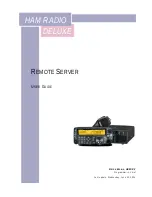
4
Introduction
This document is intended to serve as a “quick start guide” to the integration of the Mylex AcceleRAID 200 RAID
Controller into an Intel® N440BX or T440BX based server system, and subsequent configuration of a RAID array.
It is not intended to replace the Mylex AcceleRAID 200 Hardware and Software manuals that ship with that product.
There is a wealth of usable information in those publications and the user is strongly encouraged to read them in
their entirety.
As a brief review, the following definitions apply to RAID (Redundant Array of Independent Disks). RAID 0 = data
striping with no parity, it is used for performance but provides no fault tolerance. RAID 1 = mirroring, used for
maximum fault tolerance but has the disadvantage of paying for twice the storage space you have available for actual
data. RAID 3 = data striping with a dedicated parity drive, fault tolerant but has the disadvantage of losing fault
tolerance if the parity drive fails. RAID 3 has relatively high performance read but lower write performance due to
the bottleneck of the dedicated parity drive. RAID 5 = data striping with parity distributed across all drives,
optimized for true fault tolerance while still retaining high read/write data rate transfer capability.
A “Zero-channel” RAID adapter is designed to use the on-board SCSI channels of the Server Board so that the
manufacturer of the RAID solution can reduce cost by eliminating the SCSI interface from their product.
Mylex AcceleRAID 200
AcceleRAID 200 series adapters are designed to support PCI-based motherboards with embedded SCSI chips and
systems that have a PCI expansion slot designated for add-in RAID controllers. The AcceleRAID 200 adapter
upgrades Symbios SCSI chips mounted on the system board to advanced RAID SCSI channels through use of
interrupts routed to the designated PCI slot. Intel's N440BX, T440BX, NA440BX & NC440BX are examples of
such Server boards and systems. AcceleRAID adapters bring the performance and fault tolerance of RAID to entry
level and mid-range server applications at the lowest overall price.
On Intel N440BX and T440BX Server Boards, control of the on-board SCSI channels is given to the zero-channel
RAID controller by routing the interrupts from the on-board SCSI channels directly to the RAID adapter when a
zero-channel RAID product is detected in the system. Thus, the RAID adapter can effectively control the behavior of
the SCSI channels using the PCI bus and mask the SCSI interrupts from the system. The system interrupt controller
will never see interrupts from the SCSI controller directly, it will only see interrupts from the RAID adapter.
In the case of the N440BX Server Board, where there are two SCSI channels, both channels reside on the single
Symbios* 53C876 onboard SCSI controller. The Symbios SCSI BIOS or the Mylex AcceleRAID 200 must control
both SCSI channels. It is not possible to have each device control one channel.
The AcceleRAID’s performance is made possible by the use of Intel’s i960®RD 66MHz processor and the new
Mylex 86238 RAID controller chip. AcceleRAID 200 also provides full RAID 0, 1, 0+1, 3, 5, 10, 30, 50 and JBOD
(Just a Bunch of Disks) level configuration capabilities. ECC cache, supporting 4MB to 128 MB SIMM cache
memory, provides error detection and correction for maximum data protection.
Assumptions
It is assumed that the integrator has a basic familiarity with RAID, and SCSI (Small Computer System Interface). If
not, RAID and SCSI primers can be found on the Intel Corporation site
http://www.intel.com/business/ibp/servers/encyc.htm
It is further assumed that the integrator has configured an Intel N440BX or T440BX based Server system with the
following minimum components. An Intel N440BX or T440BX Server Board integrated in an approved chassis, a
minimum of one Intel Pentium® II Processor, a processor terminator card in the secondary slot 1 connector (for Intel





























